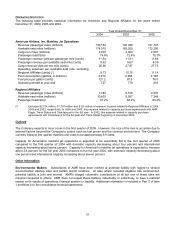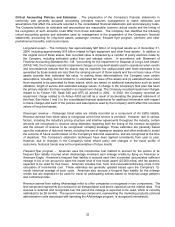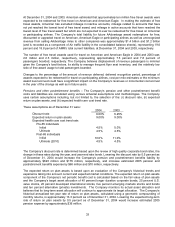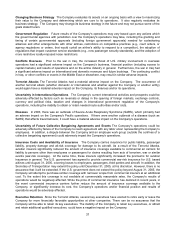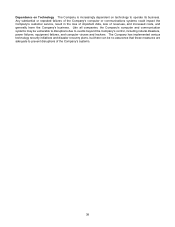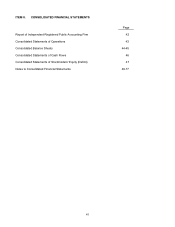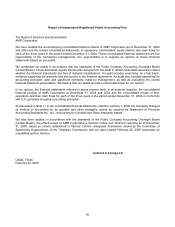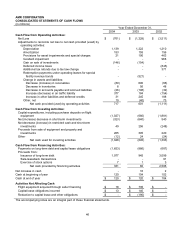American Airlines 2004 Annual Report Download - page 39
Download and view the complete annual report
Please find page 39 of the 2004 American Airlines annual report below. You can navigate through the pages in the report by either clicking on the pages listed below, or by using the keyword search tool below to find specific information within the annual report.36
Increasing Competition and Historically Low Fare Levels Service over almost all of the Company’s routes is
highly competitive and fares remain at historically low levels. The Company faces vigorous competition from major
domestic airlines, national, regional, all-cargo and charter carriers, foreign air carriers, LCCs, and, particularly on
shorter segments, ground and rail transportation. Increasingly, the Company faces significant competition from
LCCs and marketing/operational alliances formed by its competitors. The percentage of routes on which the
Company competes with carriers having substantially lower operating costs has grown significantly over the past
decade, and the Company now competes with LCCs on most of its domestic network. In addition, the Company
must compete with carriers that have recently reorganized or are reorganizing, including under the protection of
Chapter 11 of the Bankruptcy Code. It is possible that one or more other competitors may seek to reorganize in or
out of Chapter 11. Successful completion of such out-of-court or Chapter 11 reorganizations could present the
Company with competitors with lower operating costs derived from renegotiated labor, supply and financing
contracts.
Certain alliances have been granted immunity from anti-trust regulations by governmental authorities for specific
areas of cooperation, such as joint pricing decisions. To the extent alliances formed by its competitors can
undertake activities that are not available to the Company, the Company’s ability to effectively compete may be
hindered.
Pricing decisions are significantly affected by competition from other airlines. Fare discounting by competitors has
historically had a negative effect on the Company’s financial results because the Company is generally required to
match competitors' fares because failing to match would provide even less revenue. More recently, the Company
has faced increased competition from carriers with simplified fare structures, which are generally preferred by
travelers. In addition, in January 2005, Delta implemented a U.S.-wide simplified fare structure initiative, which the
Company matched in most domestic markets. No assurance can be given that any fare reduction or fare
simplification initiative will be offset by increases in passenger traffic, a reduction in costs or changes in the mix of
traffic that would improve yields. In addition, several air carriers have recently reorganized or are reorganizing
under Chapter 11 of the United States Bankruptcy Code, including United and US Airways. It is possible that other
competitors may seek to reorganize in or out of Chapter 11. Historically, air carriers involved in reorganizations
have undertaken substantial fare discounting in order to maintain cash flows and enhance customer loyalty.
Increased Pricing Transparency The increased use of the Internet as a travel distribution channel is resulting in
a continuous increase in pricing transparency. The Internet has enabled cost conscious customers, including
business travelers, to more easily obtain the lowest fare on any given route, which has reduced the Company’s
pricing power.
Cost Reduction Efforts As discussed in the Overview to this Item, the Company continues to seek to reduce its
costs. The ability of the Company to further reduce its costs, particularly without affecting operational performance
and service levels, is not assured.
Credit Ratings Since the Terrorist Attacks, AMR’s and American’s credit ratings have been lowered to
significantly below investment grade. These reductions have increased borrowing costs and otherwise adversely
affected borrowing terms, and limited borrowing options. Additional reductions in the credit ratings could further
increase borrowing or other costs and further restrict the availability of future financing.
Availability and Terms of Financing To maintain sufficient liquidity as the Company continues to implement its
restructuring and cost reduction initiatives, and because the Company has significant debt obligations maturing in
the next several years, as well as substantial pension funding obligations, the Company will need continued
access to additional financing, but there can be no assurance that such financing will be available on acceptable
terms, if at all. The Company’s ability to obtain future financing or to sell assets could be adversely affected
because American has fewer unencumbered assets available than in years past. A very large majority of the
Company’s aircraft assets (including virtually all of the aircraft eligible for the benefits of Section 1110 of the U.S.
Bankruptcy Code) have been encumbered. In addition, the market value of the Company’s aircraft assets has
declined in recent years and those assets may not maintain their current market value. Moreover, the Company’s
recent financial results, its substantial indebtedness, the difficult revenue environment it faces, and its reduced
credit ratings, coupled with high fuel prices and the financial difficulties experienced in the airline industry,
adversely affect the availability and terms of financing for the Company. The inability of the Company to obtain
additional financing on acceptable terms would have a material adverse impact on its operations.







